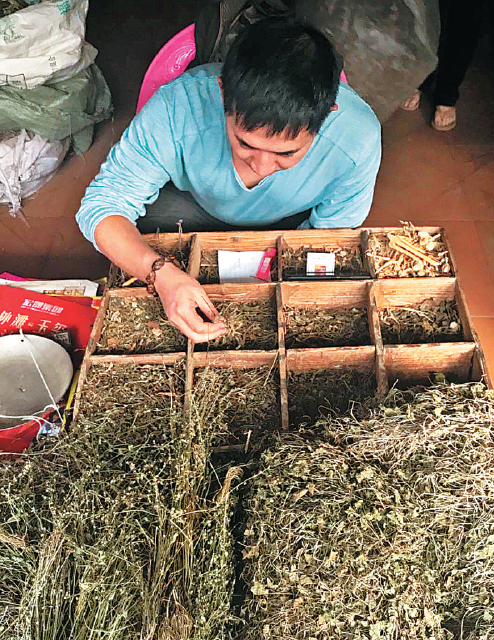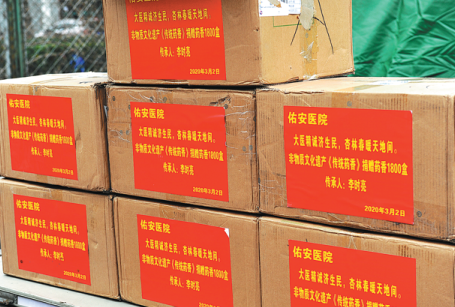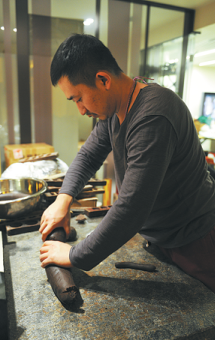Burning passion
A traditional medicinal incense maker has donated his wares amid the novel coronavirus fight, Yang Feiyue reports.

Li Shiliang recently gave away free herbal incense made from more than 10 tons of traditional Chinese medicinal ingredients to the public, including to medical workers and police officers in Beijing.
They include 20,000 scented pendants that can be worn or burned to sterilize the air, according to traditional belief.
"These herbs help to ease the body and mind, hence increasing immunity for the public and those working at the front of the epidemic," Li says.
The 40-year-old began preparing herbs for incense making after the start of the novel coronavirus outbreak.
"Right now is an extremely busy time for us medicinal-incense makers," says Li.
"But this is our responsibility."
Li is a fifth-generation inheritor of the traditional practice and was named a national-level intangible-heritage inheritor by the State Council in 2014.
Incense use can be traced back to the pre-Qin period (c. 2100-221 BC), when it was mostly used for sacrificial ceremonies.
It was found in medical prescriptions from the Western Han Dynasty (206 BC-AD 24).
In the Tang Dynasty (618-907), it was used to "sterilize" rooms, bedding and clothing, and to treat health problems.
Medicinal incense's development peaked in the Song Dynasty (960-1279), when royal families employed their own incense making departments. In the Qing Dynasty (1644-1911), the tradition of making scented sachets and pills in the first month of the lunar year was widely practiced to ward off various diseases.
Today, herbal incense is increasingly being used to alleviate pain, treat mental health issues like depression, and to make skincare and cosmetic products.
Li has focused on continuing his family's tradition of making herbal incense for medicinal purposes and expanding its use in daily life.
His family has worked in the herbal-incense business since the mid-Qing Dynasty and has preserved traditional formulas and production processes once used to make incense for the royal family.
"I saw my elderly family members giving away herbal incense to people in our neighborhood in times of need," Li says.
His grandmother was also a well-known traditional Chinese medicine practitioner. So, it has long been a family precept to help others in difficult times.
He donated 6 tons of herbal incense during the SARS outbreak in 2003.
"The incense was very popular, and my neighbors asked for it, as did my customers and their friends," Li says.
He also shares his herbal incense with those around him during seasonal changes to help them ward off colds and fevers.
"It was fun to watch my family members make incense and play with herbal pastes," Li says.
"The fragrance eventually grew on me."
This allowed him to develop a sensitive nose for herbal aromas.
By the time he was 10, Li was already able to distinguish between a number of different herbs and knew several incense recipes by heart.
After taking over the family business in 1999, Li went to university to systematically study the history and art of traditional Chinese medicine, and to complement his existing knowledge.
"I felt I needed to expand my worldview and add to the family recipes," Li says.
He acknowledges some formulas and techniques may have been lost as they were passed through the generations. As such, he sought to fill in these gaps through education.
After university, he traveled across China and abroad to learn about the rich history of incense making and local production techniques. He exchanged notes with expert incense makers in the Tibet autonomous region, and Qinghai and Yunnan provinces, and studied methods of concocting incense with ingredients grown at high altitudes.
"The way the Bai and Miao ethnic groups plant their ingredients and make incense was an eye-opener to me," Li says.
He also learned from his travels to France, Ukraine, the Middle East and South America.
"I found that we all had a lot in common and have complementary techniques and philosophies to share."
Li has integrated these experiences into his family recipes and created such products as herbal paper and teas. He has also shared his expertise with other incense makers.
In 2008, Li founded a company to produce medicinal incense for sale.
"It didn't get a mass-market response at first because I found many people associated incense with religion," Li says.
Things started to look up, however, when his business was named as a national intangible cultural heritage in 2014.
"We got more publicity in places like museums, and more people have realized that incense is part of traditional Chinese medicinal culture," he says, adding that sales have gone up since 2014.
"History proves the incense business thrives with prosperity, as public demand increases as quality of life improves," he says.
Li strictly follows tradition.
"Everything has to be natural and follow protocols that have been tested and proved," Li says.
Ingredients must be weighed carefully to ensure a balanced product, and procedures must be taken to reduce or remove unwanted properties.
For example, incense made out of red sandalwood and safflower can be used to boost blood circulation, which is good for people living in the north, because they may more likely have cardiovascular problems, especially during the chilly winters. However, red sandalwood is too potent to be used alone and must be balanced out by tea leaves, cassia cinnamon or honey, Li says.
Certain kinds of incense can only be made at particular times of year.
It takes about 24 different steps and a year to make herbal incense the old-fashioned way. The steps include selecting ingredients, screening, grinding, processing, formulating, drying, molding and packaging. Li says that he can only make around 1,000 boxes of incense a year.
He has stuck to a regular but unconventional daily routine over the years. He often wakes up and begins his day after noon because incense making usually has to take place late at night.
"Most incense is in its best condition when made at late hours of the night until the early morning," he says. "Incense made during this time smells the best and is the most potent."
He explains that it has to do with the natural ingredients' circadian rhythms.
Since Li has been living with and breathing herbs his entire life, their fragrance seems to have literally rubbed off on him.
"People say I have a herbal scent, even if I've just taken a bath," Li says.
He recently made an online video with Beijing's municipal culture and tourism bureau to teach the public how to make herbal incense at home.
"It not only helps purify the air at home but also gives residents something to do and, thus, peace of mind during the virus outbreak," Li says. To date, the video has received 400,000 views.
Li is still busy making herbal incense for those in need, especially his friends abroad, as the virus situation is growing increasingly grave around the world.
Speaking about his future plans, Li says he will continue to focus on what he has already been doing: making medicinal incense and allowing people to enjoy its benefits.



Today's Top News
- Xi urges studying, absorbing netizens' opinions in formulating 15th Five-Year Plan
- Yuan eyes greater role among safe-haven assets
- China set to clean up online health content
- China, EU can shape climate governance
- Chengdu gearing up for World Games
- Beijing, Kathmandu aim for new heights in relations






























